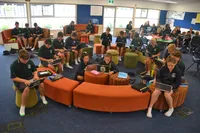It takes a teacher to bring the real world into the classroom

Editor’s Note: At Education on Air, Google’s free online conference December 3, we’ll be celebrating educators and exploring the future of education and technology. Over the next few weeks, we’ll be sharing stories and tips from some of the speakers. Register today.
Ben Thomas, a learning and digital pedagogy coordinator at Xavier High School in Albury, New South Wales, Australia, talks about his mortgage payments, tax returns, and mobile phone plans when he teaches math class. No, he’s not oversharing – he’s using his finances to explain money and economic concepts in a way that resonates with students and encourages them to take part in the conversation. We spoke to Ben to learn more about his philosophy on getting students excited about connections between what they learn, and the real world.
It takes a teacher to create a classroom that students want to be in
Ben teaches math, information technology and software design to students in grades 7-12 at the Catholic high school. With a deep desire to help young people reach their potential, teaching has always been his calling. “I considered becoming an engineer, but the thought of sitting in an office all day didn’t appeal to me,” says Ben. “Now I get to engage with students every day.”
In every lesson, Ben’s goal is to create relatable moments with students. He offers personal stories to explain concepts better than traditional lessons would. To illustrate how interest rates work, he tells students about his own mortgage and how paying it down faster helps his family save money. He’ll also tell them about the value of taking deductions on a tax return, and why it’s smart financial planning to track expenses that can become tax writeoffs.
“It’s about making your classroom a place they want to be,” Ben says.“You can see the level of engagement increase when we talk about real-world stories.” In a recent lesson, he asked each student to find out if their mobile phone plan was a good deal. By encouraging the class to compare phone plans and calculate how much data they used, Ben sparked a discussion about saving money and being smart consumers.
It takes a teacher to share stories that illuminate lessons
When building a lesson around a real-life story, Ben looks for a moment that tells him the students want to hear more. “Maybe when you start, you have a few students looking out the window, or some of them working on assignments for their next class,” Ben says. “But when you discuss a shared experience that they can relate to, all eyes are on you – and the students become the ones asking questions.”
Since Xavier is a 1:1 school, Ben also uses Chromebooks to get students to work together on projects and share their insights. He’s a fan of “app smashing,” or pulling together several apps and tools so students can create work that’s shareable and rich with insights. For example, he’ll ask students to use Google Slides paired with VideoNot.es, an app for taking notes on the same screen as watching videos, to create presentations based on their shared research.
The activity involves having students create a presentation, then using a screen recording extension, such as SnagIt or Screencastify, to record them giving their presentation. Students can leave their classmates feedback on the presentation using Videonot.es.
![[edu] students chromebooks](https://storage.googleapis.com/gweb-uniblog-publish-prod/images/DSC_0204.width-100.format-webp.webp)
It takes a teacher to spark student reflection
Much of what Ben tries to achieve with his students is reflection – that is, the ability to think about what they’re learning and consider how it impacts their lives. In mid-October, Ben, a teaching colleague, and a small group of students traveled on a week-long “immersion experience” to Barmah, Victoria where, in the 1930s, indigenous people, forced onto a reserve with poor living conditions, staged a walkout. The experience is designed to connect students to present-day indigenous people to hear about their history first-hand.
The trip, says Ben, is a perfect example of teaching that’s based on storytelling. Afterwards, one student described the lesson as “making sure that the wrongs of the past don’t happen again.” That’s the kind of reaction, Ben says, that tells teachers they’re doing a great job.
To connect with and learn from teachers like Ben, join us for Education on Air on December 3rd.
We invite you to join this movement by sharing what teachers mean to you with #ItTakesATeacher and seeing your own and others’ stories re-shared at google.com/edu/teacher.






